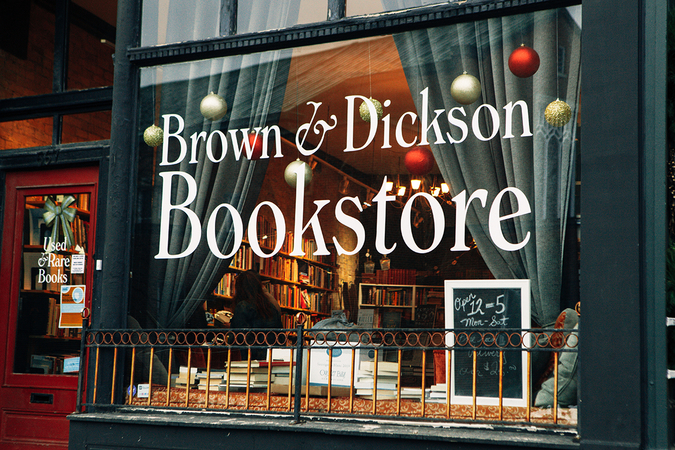Scott got me this for my birthday last year on a whim (it wasn't on my list) which usually goes poorly but in this case was a great find. Vanessa Brown, the author, runs a bookstore in London I love and used to visit frequently when I lived downtown (Brown & Dickson). Her and her partner also wrote a
fall reading list for us a few years back! Brown wrote this book based on her own fascination with London and the murder 'scene' here that took place in the 60s and onwards.
Having read Murder City, I felt pretty familiar with the various murders that took place here during the time Brown is writing about. For those who haven't- London was the serial killer capital of Canada at one time (maybe still is?) because there were so many people murdered here. In Murder City Arntfield spends a lot of time discussing why based on London's unique geography and the way the townships were divided at the time, etc. It is spooky and reading Brown's book reminded me just how crazy the numbers actually were.
 |
| Vanessa Brown |
One of my favourite things about Brown's book was her depiction of London. It's so evident she grew up here and she takes such care to provide landmarks, details, and references for those who know the area, and to paint a vivid picture for those who don't. I've lived here for twelve years now which actually feels insane, and the passage below just hits the nail on the head:

[London] has a wild vibe about it down by the river, where addicts and homeless people have set up camps, but where you can also see posh yuppies jogging along beautifully kept paved pathways. In the east end are modest, sometimes shabby, bungalows with faded plastic toys on the lawn. There are seedy motels with heart-shaped bathtubs, flea markets, and pawnshops. We also offer enormous beautiful mansions, shaded by heritage oak trees lining boulevards with cobblestone sidewalks. The summers are hot. The humidity is oppressive and the mosquitoes are massive. In the winter, you'll find yourself trudging through knee-deep snow. We're at the bottom of an ice-age valley, so your allergies act up like crazy. In between brutalist and ugly glass skyscrapers, two cathedrals chime the hours downtown and have done so for the past century; one of these has Tiffany stained-glass windows."
I also have to include this one because it's just so spot on:
Such deep contrasts mean you can experience a lot of different ways of life here. I've hung around the corner of Dundas and Richmond streets (known locally as "DNR," for all the drug addicts found there) wearing a dog collar and smoking clove cigarettes, partying with ten homeless kids in a one-bedroom apartment. I've also had dinner at the university president's manor on the northern hill of the city, overlooking wealthy Masonville. Some of the homes in Woodfield or Old North are over-the-top gorgeous, with detailed paint jobs on nineteenth-century wooden gingerbread trim, cherry wainscoting, pantries stocked with fancy jars, and living rooms you aren't allowed to sit in. At one time, London had more millionaires per capita than any other city in the country. It also has about as bad a drug problem as Vancouver."
Scott and I moved to Thorndale about 3 years ago which is just North East of the city and surprisingly the location of one of the murders referenced. I'm sure it would have been just another name of a town to me when I was reading about it in Arntfield's book...
Brown's other biggest strength is the way she connects the victims with the communities and also with their families. Arntfield was more focused on the crimes themselves where I feel Brown spends a lot of time reflecting on how communities adjusted after a murder was committed, how people talked about it, etc. I much prefer reading about crime through this lens even though it's the same stuff that keeps me up at night thinking about it.
Anne refers to her life in two ways: things happened to her either 'before Jackie' or 'after Jackie.' She doesn't say 'death,' or 'murder.' What happened to her and her family was so much more complex than a single, violent act. It was everything that came after it and the way it filtered everything that came before."
Overall I don't think I learned anything particularly new from Brown's book but if someone was wanting to read about the murders in London, with a focus on community, I would recommend it over Arntfield's book. I know I keep comparing the two as though they're similar and while they're not, there is significant content overlap.
 |
| Brown & Dickson, the cutest little antequarian bookshop run by Brown and her partner- it's basically at the intersection of Richmond & Central in downtown London |
I think its important that while these cases remain cold there is always someone out there digging at them, like Brown, even as we move further away from any hope of resolution.
'It's hard, living with a murder in the family.' The effects of the murder have never left the Awcocks. Their continued mourning is palpable... 'Everything changed,' she says. 'I became a crazy mom. I wanted to hide my kids in the closet. It was horrible.'"










This comment has been removed by a blog administrator.
ReplyDelete